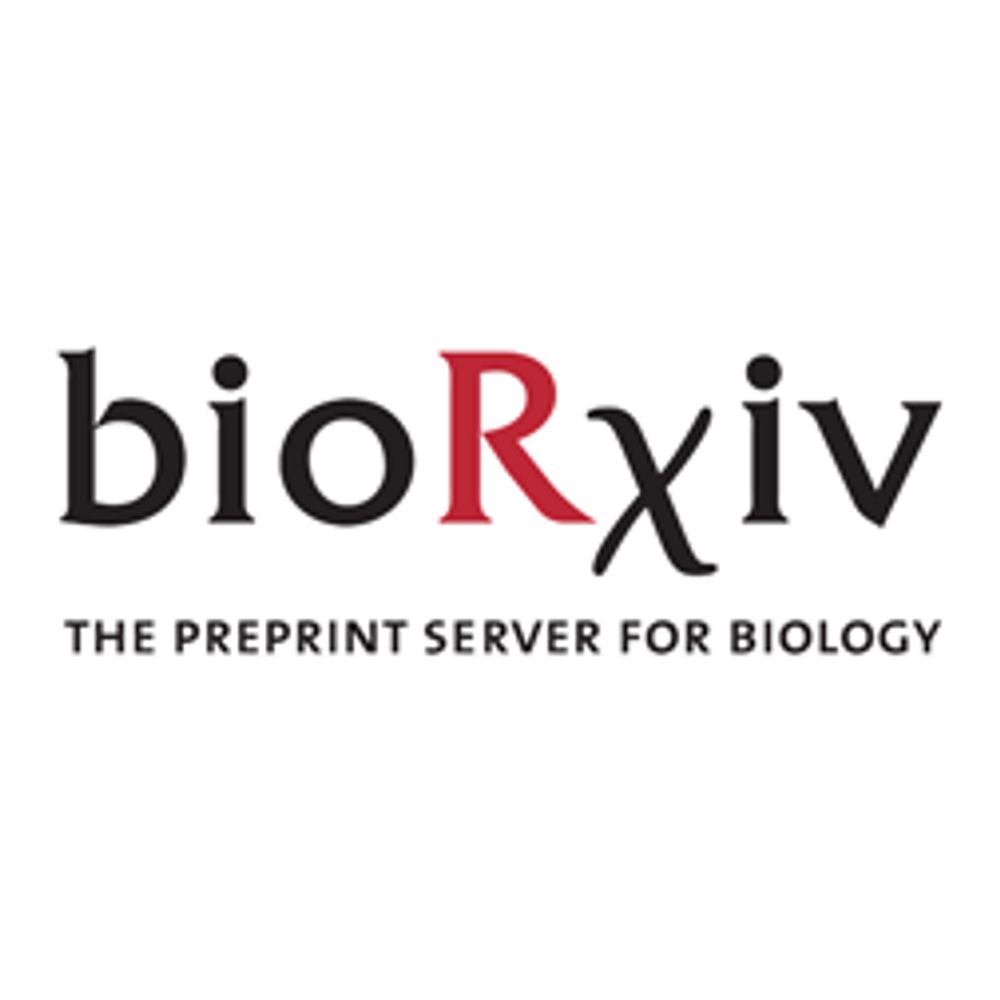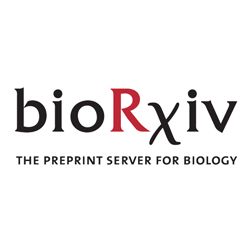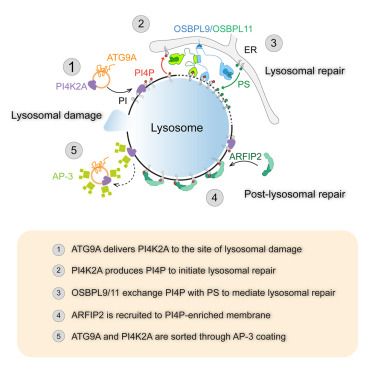The formation of ubiquitin rich condensates triggers recruitment of the ATG9A lipid transfer complex to initiate basal autophagy https://www.biorxiv.org/content/10.1101/2023.11.28.569058v1

The formation of ubiquitin rich condensates triggers recruitment of the ATG9A lipid transfer complex to initiate basal autophagy https://www.biorxiv.org/content/10.1101/2023.11.28.569058v1
Autophagy is an essential cellular recycling process that maintains protein and organelle homeostasi
www.biorxiv.org
November 29, 2023 at 11:31 PM
The formation of ubiquitin rich condensates triggers recruitment of the ATG9A lipid transfer complex to initiate basal autophagy https://www.biorxiv.org/content/10.1101/2023.11.28.569058v1
Arrayed CRISPR/Cas9 Loss-Of-Function Screen in a Neuronal Model of Adaptor Protein Complex 4 Deficiency Identifies Modulators of ATG9A Trafficking https://www.biorxiv.org/content/10.1101/2025.02.22.639634v1
February 23, 2025 at 11:31 PM
Arrayed CRISPR/Cas9 Loss-Of-Function Screen in a Neuronal Model of Adaptor Protein Complex 4 Deficiency Identifies Modulators of ATG9A Trafficking https://www.biorxiv.org/content/10.1101/2025.02.22.639634v1
What if tumors helped the immune system destroy them? A new PICI-supported study by @ucsanfrancisco.bsky.social & @washumedicine.bsky.social shows ATG9A-deficient tumors are vulnerable to macrophages. Add Trastuzumab + CSF1Ri? Full regression—no T cells: nature.com/articles/s41...

Exploitable mechanisms of antibody and CAR mediated macrophage cytotoxicity - Nature Communications
The mechanism of macrophage cytotoxicity against cancer cells requires further illustration. By employing CRISPR screening in CAR-macrophage and cancer cell co-culture system, the authors identify dep...
nature.com
July 11, 2025 at 4:48 PM
What if tumors helped the immune system destroy them? A new PICI-supported study by @ucsanfrancisco.bsky.social & @washumedicine.bsky.social shows ATG9A-deficient tumors are vulnerable to macrophages. Add Trastuzumab + CSF1Ri? Full regression—no T cells: nature.com/articles/s41...
New insights show that the protein ATG9A helps control skin inflammation by promoting autophagy, suggesting potential new targets for treating chronic skin and inflammatory diseases.

Scientists discover how cells protect the skin from inflammatory disease—paving the way for new treatments
Researchers at VIB and Ghent University have uncovered a key mechanism that protects the skin from harmful inflammation.
medicalxpress.com
October 20, 2025 at 4:27 PM
New insights show that the protein ATG9A helps control skin inflammation by promoting autophagy, suggesting potential new targets for treating chronic skin and inflammatory diseases.
ATG9A and ARFIP2 cooperate to regulate PI4P levels for lysosomal repair https://www.biorxiv.org/content/10.1101/2024.07.23.604321v1

ATG9A and ARFIP2 cooperate to regulate PI4P levels for lysosomal repair https://www.biorxiv.org/content/10.1101/2024.07.23.604321v1
Lysosome damage activates multiple pathways to prevent lysosome-dependent cell death, including a re
www.biorxiv.org
July 24, 2024 at 12:30 PM
ATG9A and ARFIP2 cooperate to regulate PI4P levels for lysosomal repair https://www.biorxiv.org/content/10.1101/2024.07.23.604321v1
Also in Issue 7:
- Research Highlights on ATG9A INVs, airway epithelia & Formin 3
- JCS–David Stephens Prize
- Emmanuel Derivery @deriverylab.bsky.social Interview
- Regulation of cell migration by ECM mechanics
- Data exploration in quantitative #cellbio
journals.biologists.com/jcs/issue/13...
- Research Highlights on ATG9A INVs, airway epithelia & Formin 3
- JCS–David Stephens Prize
- Emmanuel Derivery @deriverylab.bsky.social Interview
- Regulation of cell migration by ECM mechanics
- Data exploration in quantitative #cellbio
journals.biologists.com/jcs/issue/13...

April 17, 2025 at 2:21 PM
Also in Issue 7:
- Research Highlights on ATG9A INVs, airway epithelia & Formin 3
- JCS–David Stephens Prize
- Emmanuel Derivery @deriverylab.bsky.social Interview
- Regulation of cell migration by ECM mechanics
- Data exploration in quantitative #cellbio
journals.biologists.com/jcs/issue/13...
- Research Highlights on ATG9A INVs, airway epithelia & Formin 3
- JCS–David Stephens Prize
- Emmanuel Derivery @deriverylab.bsky.social Interview
- Regulation of cell migration by ECM mechanics
- Data exploration in quantitative #cellbio
journals.biologists.com/jcs/issue/13...
It was exciting to show that INVs function on a degradative trafficking pathway - macroautophagy - as well as on exocytic + recycling routes. The ATG9A lipid-scrambling capacity of these vesicles may be important in other membrane-remodelling contexts 🤔 Lots still to explore! 🌈 #CellBiology
September 12, 2024 at 4:24 PM
It was exciting to show that INVs function on a degradative trafficking pathway - macroautophagy - as well as on exocytic + recycling routes. The ATG9A lipid-scrambling capacity of these vesicles may be important in other membrane-remodelling contexts 🤔 Lots still to explore! 🌈 #CellBiology
Here's an autophagic punctum for you:
Small but mighty: ATG9A-positive vesicles are a branch of the intracellular nanovesicle superfamily
Some self-eating self-publicity... 🧪
doi.org/10.1080/2769...
Small but mighty: ATG9A-positive vesicles are a branch of the intracellular nanovesicle superfamily
Some self-eating self-publicity... 🧪
doi.org/10.1080/2769...

Small but mighty: ATG9A-positive vesicles are a branch of the intracellular nanovesicle superfamily
The molecular and functional characterization of the thousands of uncoated intracellular transport vesicles inside cells is a major challenge. Intracellular nanovesicles (INVs) are a large and mole...
doi.org
June 5, 2025 at 7:37 AM
Here's an autophagic punctum for you:
Small but mighty: ATG9A-positive vesicles are a branch of the intracellular nanovesicle superfamily
Some self-eating self-publicity... 🧪
doi.org/10.1080/2769...
Small but mighty: ATG9A-positive vesicles are a branch of the intracellular nanovesicle superfamily
Some self-eating self-publicity... 🧪
doi.org/10.1080/2769...
From MBoC... Dr. Francesco Scavone (Stanford) shows ATG9A has an unexpected role in trafficking K63-polyubiquitin–modified membrane proteins. Blocking the signal traps cargos in vesicle clusters; once released, they rapidly reach lysosomes. 🔗 www.molbiolcell.org/doi/10.1091/... #ASCB #CellBiology

September 10, 2025 at 1:40 PM
From MBoC... Dr. Francesco Scavone (Stanford) shows ATG9A has an unexpected role in trafficking K63-polyubiquitin–modified membrane proteins. Blocking the signal traps cargos in vesicle clusters; once released, they rapidly reach lysosomes. 🔗 www.molbiolcell.org/doi/10.1091/... #ASCB #CellBiology
Online now: ATG9A-mediated autophagy prevents inflammatory skin disease by limiting TNFR1-driven STING activation and ZBP1-dependent cell death

ATG9A-mediated autophagy prevents inflammatory skin disease by limiting TNFR1-driven STING activation and ZBP1-dependent cell death
TNF and type I IFNs are recognized as important drivers of skin inflammation. Priem et al. show that LC3-independent autophagy represses the ability of TNFR1 to directly trigger cGAS/STING-dependent type I IFN production and ZBP1 cytotoxicity, which prevents the development of a severe inflammatory skin disorder.
dlvr.it
October 20, 2025 at 2:49 PM
Online now: ATG9A-mediated autophagy prevents inflammatory skin disease by limiting TNFR1-driven STING activation and ZBP1-dependent cell death
The formation of ubiquitin rich condensates triggers recruitment of the ATG9A lipid transfer complex to initiate basal autophagy https://www.biorxiv.org/content/10.1101/2023.11.28.569058v1

The formation of ubiquitin rich condensates triggers recruitment of the ATG9A lipid transfer complex to initiate basal autophagy https://www.biorxiv.org/content/10.1101/2023.11.28.569058v1
Autophagy is an essential cellular recycling process that maintains protein and organelle homeostasi
www.biorxiv.org
November 29, 2023 at 11:31 PM
The formation of ubiquitin rich condensates triggers recruitment of the ATG9A lipid transfer complex to initiate basal autophagy https://www.biorxiv.org/content/10.1101/2023.11.28.569058v1
Mary did a great job and her work raises some interesting questions about ATG9A function and localisation.
January 18, 2025 at 7:30 AM
Mary did a great job and her work raises some interesting questions about ATG9A function and localisation.
Our work on K63-polyubiquitin in membrane trafficking is out! Check out how we use a high affinity and specific sensor for K63-polyUb to identify K63-polyubiquitylated plasma membrane proteins in clusters of vesicles containing ATG9A.
Link: www.molbiolcell.org/doi/10.1091/...
Link: www.molbiolcell.org/doi/10.1091/...

Trafficking of K63-polyubiquitin modified membrane proteins in a macroautophagy-independent pathway is linked to ATG9A | Molecular Biology of the Cell
Cytoplasmic K63-linked polyubiquitin signals have well-established roles in endocytosis and selective autophagy. However, how these signals help to direct different cargos to different intracellular t...
www.molbiolcell.org
February 24, 2025 at 6:48 AM
Our work on K63-polyubiquitin in membrane trafficking is out! Check out how we use a high affinity and specific sensor for K63-polyUb to identify K63-polyubiquitylated plasma membrane proteins in clusters of vesicles containing ATG9A.
Link: www.molbiolcell.org/doi/10.1091/...
Link: www.molbiolcell.org/doi/10.1091/...
Kremen1 dependence receptor induces SEC24C- and ATG9A-dependent autophagic cell death https://www.biorxiv.org/content/10.1101/2025.01.15.633131v1
January 16, 2025 at 7:50 AM
Kremen1 dependence receptor induces SEC24C- and ATG9A-dependent autophagic cell death https://www.biorxiv.org/content/10.1101/2025.01.15.633131v1
Kremen1 dependence receptor induces SEC24C- and ATG9A-dependent autophagic cell death https://www.biorxiv.org/content/10.1101/2025.01.15.633131v1
January 16, 2025 at 7:50 AM
Kremen1 dependence receptor induces SEC24C- and ATG9A-dependent autophagic cell death https://www.biorxiv.org/content/10.1101/2025.01.15.633131v1
ATG9A and ARFIP2 cooperate to regulate PI4P levels for lysosomal repair https://www.biorxiv.org/content/10.1101/2024.07.23.604321v1

ATG9A and ARFIP2 cooperate to regulate PI4P levels for lysosomal repair https://www.biorxiv.org/content/10.1101/2024.07.23.604321v1
Lysosome damage activates multiple pathways to prevent lysosome-dependent cell death, including a re
www.biorxiv.org
July 24, 2024 at 12:30 PM
ATG9A and ARFIP2 cooperate to regulate PI4P levels for lysosomal repair https://www.biorxiv.org/content/10.1101/2024.07.23.604321v1
Very proud to have our paper on ATG9A in lysosome repair online. ATG9A never disappoints! Great work from the very talented @stedet.bsky.social and @ealmacellas.bsky.social 👍
www.sciencedirect.com/science/arti...
www.sciencedirect.com/science/arti...

ATG9A and ARFIP2 cooperate to control PI4P levels for lysosomal repair
Lysosome damage activates multiple pathways to prevent lysosome-dependent cell death, including a repair mechanism involving endoplasmic reticulum (ER…
www.sciencedirect.com
June 4, 2025 at 9:39 PM
Very proud to have our paper on ATG9A in lysosome repair online. ATG9A never disappoints! Great work from the very talented @stedet.bsky.social and @ealmacellas.bsky.social 👍
www.sciencedirect.com/science/arti...
www.sciencedirect.com/science/arti...
A lipid transfer-dependent feedback loop activates ATG9A compartments in autophagy initiation www.biorxiv.org/content/10.1...

A lipid transfer-dependent feedback loop activates ATG9A compartments in autophagy initiation
Autophagy degrades cellular material by sequestering it in autophagosomes, which form de novo from precursors called phagophores. Phagophore assembly and expansion require ATG9A-positive seed compartm...
www.biorxiv.org
August 19, 2025 at 3:17 PM
A lipid transfer-dependent feedback loop activates ATG9A compartments in autophagy initiation www.biorxiv.org/content/10.1...
miRNA family miR-29 inhibits PINK1-PRKN dependent mitophagy via ATG9A https://www.biorxiv.org/content/10.1101/2024.01.17.576122v1

miRNA family miR-29 inhibits PINK1-PRKN dependent mitophagy via ATG9A https://www.biorxiv.org/content/10.1101/2024.01.17.576122v1
Loss-of-function mutations in the genes encoding PINK1 and PRKN result in early-onset Parkinson dise
www.biorxiv.org
January 20, 2024 at 2:21 PM
miRNA family miR-29 inhibits PINK1-PRKN dependent mitophagy via ATG9A https://www.biorxiv.org/content/10.1101/2024.01.17.576122v1
*ATG9A alert*👀👀
Curious about how ATG9A maintains lysosomal homeostasis via PI4P? Check out the new work from my postdoc in @satooze.bsky.social lab.
Thrilled to see this finally published!
Special thanks to @ealmacellas.bsky.social
www.sciencedirect.com/science/arti...
Curious about how ATG9A maintains lysosomal homeostasis via PI4P? Check out the new work from my postdoc in @satooze.bsky.social lab.
Thrilled to see this finally published!
Special thanks to @ealmacellas.bsky.social
www.sciencedirect.com/science/arti...

ATG9A and ARFIP2 cooperate to control PI4P levels for lysosomal repair
Lysosome damage activates multiple pathways to prevent lysosome-dependent cell death, including a repair mechanism involving endoplasmic reticulum (ER…
www.sciencedirect.com
June 3, 2025 at 7:22 AM
*ATG9A alert*👀👀
Curious about how ATG9A maintains lysosomal homeostasis via PI4P? Check out the new work from my postdoc in @satooze.bsky.social lab.
Thrilled to see this finally published!
Special thanks to @ealmacellas.bsky.social
www.sciencedirect.com/science/arti...
Curious about how ATG9A maintains lysosomal homeostasis via PI4P? Check out the new work from my postdoc in @satooze.bsky.social lab.
Thrilled to see this finally published!
Special thanks to @ealmacellas.bsky.social
www.sciencedirect.com/science/arti...
Role of N-glycosylation as a determinant of ATG9A conformations and activity https://www.biorxiv.org/content/10.1101/2025.01.17.633517v1
January 21, 2025 at 4:26 AM
Role of N-glycosylation as a determinant of ATG9A conformations and activity https://www.biorxiv.org/content/10.1101/2025.01.17.633517v1
ATG9A assists lysosome membrane repair. Our preview on the Tooze lab’s paper is now online and free thru this link: authors.elsevier.com/a/1lzTz5Sx5g...
October 20, 2025 at 9:10 PM
ATG9A assists lysosome membrane repair. Our preview on the Tooze lab’s paper is now online and free thru this link: authors.elsevier.com/a/1lzTz5Sx5g...
Arrayed CRISPR/Cas9 Loss-Of-Function Screen in a Neuronal Model of Adaptor Protein Complex 4 Deficiency Identifies Modulators of ATG9A Trafficking
www.biorxiv.org/content/10.1...
www.biorxiv.org/content/10.1...

Arrayed CRISPR/Cas9 Loss-Of-Function Screen in a Neuronal Model of Adaptor Protein Complex 4 Deficiency Identifies Modulators of ATG9A Trafficking
Biallelic loss-of-function variants in the adaptor protein complex 4 (AP-4) disrupt trafficking of transmembrane proteins at the trans-Golgi network, including the autophagy-related protein 9A (ATG9A)...
www.biorxiv.org
February 24, 2025 at 3:56 PM
Arrayed CRISPR/Cas9 Loss-Of-Function Screen in a Neuronal Model of Adaptor Protein Complex 4 Deficiency Identifies Modulators of ATG9A Trafficking
www.biorxiv.org/content/10.1...
www.biorxiv.org/content/10.1...
This is a summary of our recent @jcellsci.bsky.social paper.
If you've ever wondered why ATG9A has many and varied roles, we think it's because it is trafficked by a subset of a large, diverse family of vesicles - intracellular nanovesicles.
doi.org/10.1242/jcs....
If you've ever wondered why ATG9A has many and varied roles, we think it's because it is trafficked by a subset of a large, diverse family of vesicles - intracellular nanovesicles.
doi.org/10.1242/jcs....

ATG9A vesicles are a subtype of intracellular nanovesicle
Highlighted Article: Presentation of the first intracellular nanovesicle (INV) proteome, showing that a subset of INVs are ATG9A vesicles. This places ATG9A vesicles in a broader superfamily of traffi...
doi.org
June 5, 2025 at 7:41 AM
This is a summary of our recent @jcellsci.bsky.social paper.
If you've ever wondered why ATG9A has many and varied roles, we think it's because it is trafficked by a subset of a large, diverse family of vesicles - intracellular nanovesicles.
doi.org/10.1242/jcs....
If you've ever wondered why ATG9A has many and varied roles, we think it's because it is trafficked by a subset of a large, diverse family of vesicles - intracellular nanovesicles.
doi.org/10.1242/jcs....

